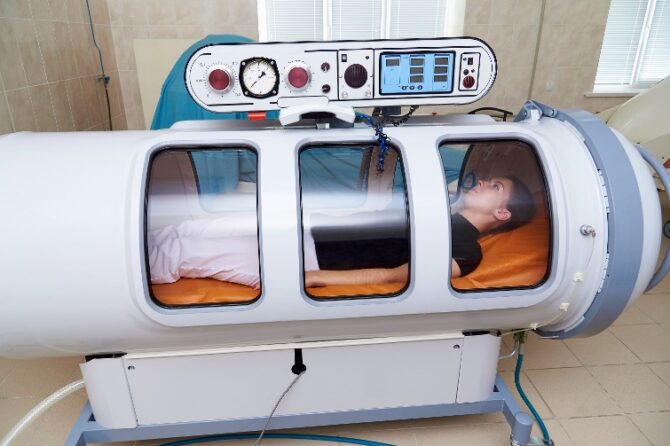
Hyperbaric chambers (Hyperbaric Oxygen Therapy) operate with 100% oxygen, typically at pressures from 2 to 3 atmospheres. They are inherently dangerous and require medical supervision. First invented in the early 1900s and introduced more routinely for clinical treatments in the 1960s, they were developed for the treatment of carbon monoxide and cyanide poisoning, gangrene, crushing injuries and decompression sickness. Common side effects can include eye damage, sinus- and middle ear problems. More rarely, oxygen poisoning can lead to seizures, fluid in the lungs and/or lung failure.
The high pressure in a hyperbaric chamber is necessary to increase the oxygen concentration in plasma (the clear fluid in blood that accounts for about 50% of blood volume) but it doesn’t have a significant effect on the main oxygen-carrying component of blood, the hemoglobin of red blood cells.
The entire blood volume of a normal adult contains about 15 ml of dissolved oxygen at one atmosphere. Adults consume approximately 250 ml of oxygen per minute, so the oxygen dissolved in plasma is clearly not the most important component for the delivery of oxygen under normal circumstances (this is the function of the red blood cell). However, plasma in a hyperbaric chamber typically saturates at 10 to 20 times the saturation level at standard atmospheric pressure, which can be particularly beneficial for the treatment of crushing wounds which have compromised capillary blood flow and may not have access to circulating red blood cells.

Hyperbaric chambers (Hyperbaric Oxygen-Hydrogen Therapy) are a progression of the hyperbaric chamber, bringing many of the benefits of oxygen therapy without the risks. They are safe, operating below 1.5 atmospheres, and they use a mixture of gasses – with oxygen levels of only 40% (about 2X the concentration found in air), 1.5% carbon dioxide (about 50X that of air) and 0.5% hydrogen (10,000X the concentration in air). The purpose of the oxygen, as in the hyperbaric chamber, is to promote oxygen saturation in peripheral tissue. The increased carbon dioxide is important for efficient gas exchange in the hemoglobin molecule (the Bohr effect), and molecular hydrogen acts as a free radical scavenger to provide cytoprotection (primarily by increasing the levels of antioxidant enzymes such as superoxide dismutase and catalase. This effect is also supported by the ingestion of hydrogen-rich water, available in the chamber).
The erythrocyte (red blood cell) is responsible for transporting oxygen (02) and carbon dioxide (CO2) in tissue to support metabolism and keep us alive. In an exquisitely balanced reaction, molecular oxygen in the lungs binds to hemoglobin molecules in red blood cells, which transport it to peripheral cells in the body. There, in response to decreased oxygen concentrations in the tissue, the hemoglobin releases 02 and binds waste carbon dioxide for transport to the lungs. Back in the lungs, the waste CO2 is released in exchange for 02 (which has a much higher affinity for binding sites in the hemoglobin molecule than CO2) and the process repeats with an average cycle time of about 30 seconds.
Under normal conditions this process maintains an average oxygen saturation level (the percentage of hemoglobin with bound oxygen) of 97% to 100% in arterial blood. Hemoglobin in venous blood has an average saturation of around 72% oxygen. But there is a gradient – oxygen concentration is highest in the arteries of the lungs and lowest in the peripheral capillaries. In fact, cells at the ends of the smallest capillaries are routinely in a state of near oxygen starvation (this is why vision can temporarily narrow or cause one to see “stars” when suddenly standing up from a resting position, until increased heart rate and blood pressure restores the proper 02/CO2 balance in the tissues of the retina).
Follow us to read Part 2 of this article.



